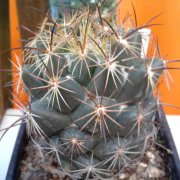Care of the cacti Coryphantha pallida or Pale coryphantha |
|
The genus Coryphantha, family Cactaceae, includes 40 species of cactus native to Mexico and the southwestern United States. Some species are: Coryphantha pallida, Coryphantha ottonis, Coryphantha octacantha, Coryphantha maiz-tablasensis, Coryphantha macromeris, Coryphantha elephantides, Coryphantha durangensis, Coryphantha cornifera, Coryphantha compacta, Coryphantha andreae, Coryphantha sulcata, Coryphantha werdermannii, Coryphantha recurvata. Common name: Pale coryphantha. This species is native to Puebla and Oaxaca, Mexico. They are small cacti with a globular body (up to 12 cm/4.72" in diameter) of bluish green color that can form groups. They have short, thick tubercles with more than 20 radial spines and a longer black central spine (up to 1.5 cm/0,59"). In the upper part of the plant the wooliness is abundant. The showy yellow flowers are 7 cm (2.75") in diameter. They bloom in summer from 4-5 years of age. Pale coryphantha is used in pots and planters; if it produces suckers, is used in rockeries and in gardens of cacti and succulents. Coryphantha pallida prefers full sun exposure. In winter the temperature should not be less than 3 ºC (37.4 ºF). The soil can be a mixture of equal parts siliceous coarse sand, black peat, blond peat and heather soil or a commercial substrate for cacti and succulents. Water once a week in summer, every 12-15 days in spring, every 20-25 in autumn and do not water in winter. Fertilize in mid-spring with mineral cactus fertilizer. No pruning. Coryphantha pallida only presents pest and disease problems if there is excess watering or the humidity is very high (they need good ventilation). Pale coryphantha propagates by seeds sown in spring in a seedbed in slightly damp sandy substrate. |
Images of the cacti Coryphantha pallida or Pale coryphantha |
Find plants
Coryphantha pallida or Pale coryphantha | Care and Growing
© 2025 FavThemes





